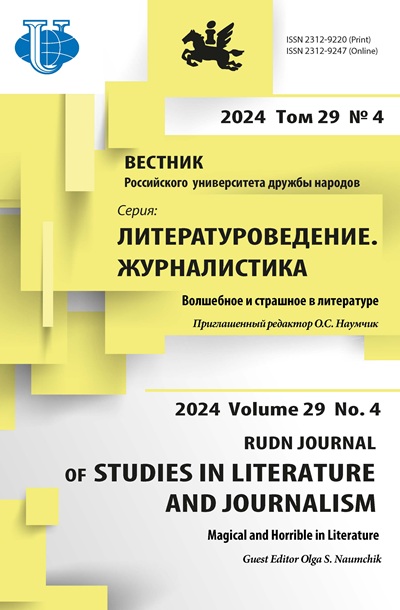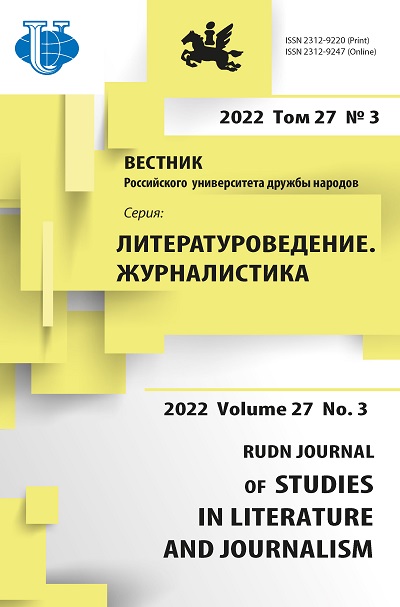Analysis of the representation of environmental issues in the social networks of regional Internet media
- Authors: Lobodenko L.K.1, Perevozova O.V.1, Cherednyakova A.B.1, Kharitonova O.Y.1
-
Affiliations:
- South Ural State University
- Issue: Vol 27, No 3 (2022)
- Pages: 600-614
- Section: JOURNALISM
- URL: https://journals.rudn.ru/literary-criticism/article/view/32313
- DOI: https://doi.org/10.22363/2312-9220-2022-27-3-600-614
Cite item
Full Text
Abstract
A quantitative analysis of environmental content was carried out in the profile groups of social networks of regional Internet media, specifically in the social network VKontakte, popular among young people. An attempt to measure the degree of involvement of the media audience in the environmental issues of the region is presented, an assessment of social reflection on environmental texts is given. The dynamics (through likes, reposts and comments) of social well-being, typical for the audience of regional online media, has been revealed. The most popular resources were used as empirical material - the online publications “74.ru” and “1obl.ru.” A theoretical review of sources on the issue under study, including the work of domestic and foreign scientists of various specialties, is presented. Qualitative results have been achieved: linguistic features of text construction, reflecting the audience's reaction to environmental events, have been identified. The novelty of the study lies in the chosen approach and perspective of the problem, in the combination of methods used to collect data, in particular, a comparative analysis of the presentation of environmental information in official media sources and their representation in social networks was carried out. The main conclusion obtained in the course of the study is that the ecotexts of an environmentally problematic region do not provide high user involvement, while they indirectly express behavioral intentions, audience reactions, including social well-being.
About the authors
Lidia K. Lobodenko
South Ural State University
Email: lobodenkolk@susu.ru
ORCID iD: 0000-0002-0809-1686
Ph.D. in Philology, Director of the Institute of Media and Socio-Humanitarian Sciences, Professor of Advertising and Public Relations Department
76 Prospekt Lenina, Chelyabinsk, 454080, Russian FederationOlga V. Perevozova
South Ural State University
Author for correspondence.
Email: perevozovaov@susu.ru
ORCID iD: 0000-0002-1593-1727
Associate Professor, Candidate of Pedagogical Sciences, Associate Professor of Advertising and Public Relations Department
76 Prospekt Lenina, Chelyabinsk, 454080, Russian FederationAnna B. Cherednyakova
South Ural State University
Email: cheredniakovaab@susu.ru
ORCID iD: 0000-0002-5681-8800
Doctor of Pedagogical Sciences, Associate Professor of Advertising and Public Relations Department
76 Prospekt Lenina, Chelyabinsk, 454080, Russian FederationOlga Yu. Kharitonova
South Ural State University
Email: kharitonovaoi@susu.ru
ORCID iD: 0000-0001-6124-3055
PhD in History, Associate Professor of Advertising and Public Relations Department
76 Prospekt Lenina, Chelyabinsk, 454080, Russian FederationReferences
- Anisimova, A.S. (2016). Internet relations in modern society: Problems of streamlining. Science Journal of Volgograd State University. Series 5. Jurisprudence, 30(1), 58–63. (In Russ.)
- Bennett, L.W. (2003). Communicating global activism: Strengths and vulnerabilities of networked politics. Information, Communication & Society, 6(2), 143–168. http://doi.org/10.1080/1369118032000093860
- Dobrinskaya, D.E. (2016). Sociological understanding of Internet: Theoretical approaches to the network analysis. Moscow State University Bulletin. Series 18. Sociology and Political Science, 22(4), 43–64. (In Russ.) http://doi.org/10.24290/1029-3736-2016-22-4-43-64
- Dridze, T.M. (1996). Social communication as a textual activity in semiosociopsychology. Social Sciences and Modernity, (3), 145–152. (In Russ.)
- Han, R., & Xu, J. (2020). A comparative study of the role of interpersonal communication, traditional media and social media in pro-environmental behavior: A China-based study. International Journal of Environmental Research and Public Health, 17(6), 1883. http://doi.org/10.3390/ijerph17061883
- Han, W., McCabe, S., Wang, Y., & Chong, A.Y.L. (2018). Evaluating user-generated content in social media: An effective approach to encouraging greater pro-environmental behavior in tourism? Journal of Sustainable Tourism, 26(4), 600–614. http://doi.org/10.1080/09669582.2017.1372442
- Hynes, N., & Wilson, J. (2016). I do it, but don't tell anyone! Personal values, personal and social norms: Can social media play a role in changing pro-environmental behaviours? Technological Forecasting and Social Change, 111, 349–359. http://doi.org/10.1016/J.TECHFORE.2016.06.034
- Karpus, Ch.T. (2018). Fifteen minutes of shame: Social media and 21st century environmental activism. Villanova Law Environmental Law Journal, 29(1), 101.
- Liu, Y., & Li, X. (2021). Pro-environmental behavior predicted by media exposure, SNS involvement, and cognitive and normative factors. Environmental Communication, 15(7), 954–968. http://doi.org/10.1080/17524032.2021.1922479
- Lobodenko, L.K., & Bashtanar, I.M. (2016). Regional Internet media in social networks: Transformation of media content. Philology. Theory & Practice, 69(5, part 3), 29–34 (In Russ.)
- Ma, D. (2012). Visualizing of social media data: Mapping changing social networks. Dis. Theses. University of Twente.
- Malathi, A., & Radha, D. (2016). Analysis and visualization of social media networks. 2016 International Conference on Computation System and Information Technology for Sustainable Solutions (pp. 58–63). http://doi.org/10.1109/CSITSS.2016.7779440
- Muniz-Rodriguez, K., Ofori, S.K., Bayliss, L.C., Schwind, J.S., Diallo, K., Liu, M., Yin, J., Chowell, G., & Fung, I.C.H. (2020). Social media use in emergency response to natural disasters: A systematic review with a public health perspective. Disaster Medicine and Public Health Preparedness, 14(1), 139–149. http://doi.org/10.1017/dmp.2020.3
- Nielsen, R.K., & Schrøder, K.C. (2014). The relative importance of social media for accessing, finding and engaging with news: An eight-country cross-media comparison. Digital Journalism, 2(4), 472–489. http://doi.org/10.1080/21670811.2013.872420
- Obukhov, K.N. (2008). Network as the social structure: Model of net communication in Manuel Castell’s theory. Bulletin of Udmurt University. Series: Philosophy. Psychology. Pedagogy, 3(1), 107–110. (In Russ.)
- Selezenev, R.S., & Skripak, R.I. (2013). Social networks as a phenomenon of information society and specific social relations within them. Bulletin of Kemerovo State University, (2–3), 125–131. (In Russ.)
- Slaughter, L.D. (2008). TreeHuggerTV: Re-visualizing environmental activism in the post-network era. Environmental Communication: A Journal of Nature and Culture, 2(2), 212–228. http://doi.org/10.1080/17524030802141760
- Snook, K., Duke, C., Finch, K., Fu, K.-W., Tse, Z.T.H., Adhikari, A., & Fung, I.C.-H. (2015). How social media is used during natural disasters, environmental disasters, and other environmental concerns: a scoping review. 8th Annual Conference on the Science of Dissemination and Implementation in Health Retrieved May 9, 2022, from https://academyhealth.confex.com/academyhealth/2015di/meetingapp.cgi/Paper/7749
- Sovacool, B.K., Xu, X., De Rubens, G.Z., & Chen, C.-F. (2020). Social media and disasters: Human security, environmental racism, and crisis communication in hurricane Irma Response. Environmental Sociology, 6(3), 291–306. http://doi.org/10.1080/23251042.2020.1753310
- Zhbannikova, O.D. (2016). Forms and methods of covering environmental problems in Russian Internet resources. Barnaul: Altai State University. (In Russ.)
















